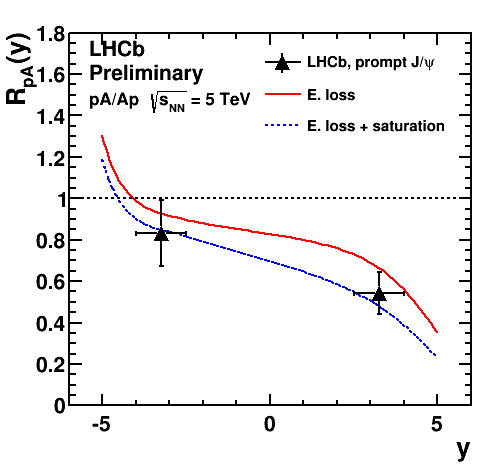The LHCb Collaboration has just presented at the Workshop on proton-nucleus collisions at the LHC, Trento, Italy, the first results from the analysis of proton with lead ion collision run data taken in January-February 2013. Already these first results made an important contribution to the understanding of heavy ion collisions.
In the Standard Model of Cosmology quarks and gluons were freely moving in a state called a quark-gluon plasma until < 10-5 seconds after the Big Bang. As the Universe cooled, they became confined inside protons and neutrons. The theory of quark-gluon interactions, the strong force interaction theory, QCD, predicts that the state of quark-gluon plasma can also exists in high temperature matter created by high energy collisions between large atomic nuclei, called by physicists heavy ion collisions. But how to prove that the quark-gluon plasma is really formed? A reduced rate of J/ψ particle production in heavy ion collisions was considered as a “smoking gun” argument in favour of quark-gluon plasma formation by physicists analysing results of measurements performed in the CERN Super Proton Synchrotron (SPS) after 1986 and more recently in the Brookhaven RHIC collider. Profound analysis has shown, however, that reality is more complicated. In some models, for example, the J/ψ particle could also be regenerated in nuclear matter, partons (quark, gluons) could be saturated and/or lose energy, etc. in normal (so called cold) nuclear matter.
Data recording collisions of protons with lead ions were collected in the LHC experiments in January-February this year. In such collisions, formation of a quark-gluon plasma is not expected, and therefore measurements based on these data allow the study of interactions in cold nuclear matter. The analysis of J/ψ production was of particular interest.
The LHCb results are shown in the image at the left hand side. A reduced value of the nuclear attenuation factor RpA, the ratio of the J/ψ production in the proton with lead ion (pA) collisions to that in proton-proton collisions as a function of the rapidity y is clearly seen. The rapidity variable is related to the J/ψ production angle with respect to the incoming proton direction. The experimentally measured points (triangles with error bars) in the image show that the largest suppression is in the forward direction.
The colored distributions show theoretical predictions of RpA calculated by François Arleo from LAPTH, Annecy and Stéphane Peigné from Subatech, Nantes, taking into account the J/ψ energy loss (E. loss) in cold nuclear matter with and without the parton saturation effects. The LHCb results are in agreement with these predictions.
Two sets of data were taken: pA and Ap, where in the second case the direction of the proton and lead ion beams were reversed. This allowed the LHCb detector, recording the particles only on one side of the interaction point, to make measurements in both forward and backward directions with respect to the proton beam (positive and negative rapidity).
click the image for higher resolution
Read more in the LHCb presentation in Trento and in the LHCb conference note.

